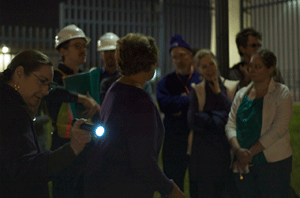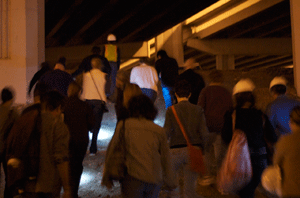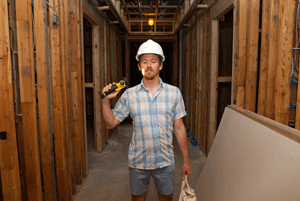Artist Keith Wilson launched the Cave & Mountain Tour in 2009 as an attempt to get people out from behind their computers and into the world of brick and mortar. For each tour, Wilson employs a different tour guide persona; the tours often veer into the realm of fiction but the performance’s goal is not to deceive. Rather, they call attention to the truths and legends of our urban landscape and civic history and, perhaps most importantly, force participants to question their own involvement in “truth.” In November 2009, Wilson teamed up with Subtext Projects, a curatorial collaborative in Fort Worth headed by Alison Hearst and Erin Starr White, to bring the Cave & Mountain Tour to Fort Worth. This spring, Hearst and Starr White spoke to Wilson about the project, performance art and Abraham Lincoln.
Subtext Projects (SP): You began the Cave & Mountain Tour earlier this year in Austin, in which you assume different tour guide personas and lead audiences on bicycle and walking tours throughout the city. What prompted you to make Fort Worth a tour destination?
KW: I read about Subtext Projects in a recent issue of …might be good and was really excited by what you had started. I lived in Fort Worth while an undergrad at TCU, where I got my Bachelor’s degree in history and sociology. My memories of life there include very little contemporary or experimental art, both because I wasn’t looking and, I think, because it wasn’t easy to find. What was part of my Fort Worth experience was trying to find interesting things to see and do and explore with little money and little guidance. I’m big on walking and I did a lot of it while at TCU—in the fancy neighborhoods, under power lines, in the so, so many strip malls at night; that’s entertainment for me.
SP: The tours could primarily be labeled as performance art, yet your background is chiefly as a documentary film director. How has your experience as a filmmaker informed this project, and why did you decide to reposition yourself as an actor of sorts on the tours?
KW: Even though most of my creative practice revolves around the moving image—my MFA and my current teaching position are in film production—performance has always played a role in my work. I’ve always had a bit of a split personality when it comes to wanting to be behind the camera vs. performing for it. Many of my films are personal, and often I’m both the subject and the one holding the camera.
In my documentary films and in all my work, I want to provide viewers/participants with new ways of experiencing the ordinary and the overlooked. I think it comes from a need to entertain myself in the heterogeneous, safe, boring, cookie-cutter suburban Atlanta environment where I grew up. What’s a curious, gay boy to do but make shit up about a place with little history, culture or pizzazz? If someone walks away from one of my films, photographs or performances and experiences their same ol’ world differently, then I’ve done the job I set out to do.
SP: How do parody and myth creation relate to the project? And does the existence of your alter ego du jour change participants’ views of the city being toured?
KW: In 2004, I was in Springfield, Illinois working on a film and visited the birthplace of Abraham Lincoln, which is run by the United States Park Service. It was right around the time when one of the many books about Lincoln’s possible gayness was published, yet there was absolutely zero mention of it on the tour. As expected, our guide painted Lincoln as legend, as perfect, as the quintessential American rags-to-riches hero. The crowd (myself included) ate it up. We were more concerned with posing for the camera than critiquing the construction of American mythology. And I don’t think the tour—given by a scarily dutiful guide—should have necessarily included information regarding the ‘Lincoln was a homo’ debate. But I would love, for once, to have as close to a “fair and balanced” account of a historical place and an “important” person as possible. Having said that, I realize the impossibility of unbiased presentations of history and biography. It’s not possible, so why try, right? That’s where the Cave & Mountain Tour comes in.
SP: Reminiscent of Allan Kaprow’s happenings in New York in the 1960s and done outside the bounds of the gallery and museum system, the tours blur the distinction between art and everyday life. Further, the audience members are participants in the piece, actively engaged with their surroundings. Coming as you did—from film—are early performance art and Fluxus a part of your artistic heritage?
KW: I saw a Kaprow retrospective at the Los Angeles Museum of Contemporary Art last summer and was so turned on by how many strategies he employed to get people to participate in his work and in the experience and process of artmaking. I like the playfulness of Kaprow’s work and the attempt to integrate art with life. I like to think that the blurring of fact and fantasy on my tours does this too. I also respond to Kaprow’s ideas around un-art. That art is not really “art” at all, but just life—that the two need not be segregated in terms of discourse, exhibition and public interaction. This approach is also what I love about the work of Harrell Fletcher, who is my favorite artist at the moment.
SP: In a similar vein, assuming the role of a tour guide–especially a satirical one–also evokes many of the critical elements posed in Andrea Fraser’s Museum Highlights. As Fraser played the part of Jane Castleton, the upper-class museum docent, to unsuspecting visitors at the Philadelphia Museum of Art in 1989, she critiqued the institution, how it presents itself to the public and also how the museum veils certain information from the community. Can you talk about how a project such as this may relate to the Cave & Mountain Tour? What other influences may have shaped the tours and how?
KW: Oh to have been an unsuspecting museum visitor for Fraser’s performance of Museum Highlights. I could have died happy. In my opinion, getting duped has heaps of social and personal value, but only if the intention is to instigate the critique of institutions or group think or myth or pop culture or whatever. Art that attempts to make people feel stupid is not attractive to me. I’m not a fan of know-it-all asshole artists or tour guides. I’ve never seen a Fraser performance in person, so I can’t say if she’s a jerk, but my tour guides try hard not to be.
SP: In relation to Fraser, whose tours hinge on the location in which they inhabit, do the Cave & Mountain Tours rely solely upon the sites they occupy? Or, is the position of the “tour guide” also a site in which you aim to critique?
KW: Oh definitely. For me, the guide is the one who shapes the tour-going experience more than anything else. They set the tone, create the pace and give the information and geography a human touch. And while my tours are critiques of the tour guide as gate keeper, they also provide tour participants with that bizarre and unique interaction that happens between strangers on tours. When a tour begins, so does the group process of negotiating authority, personal space and group dynamics. There’s usually at least one dumb question asker and one person who doesn’t follow the no-flash photography rule. There’s often one total jackass.
While we’re on influences, I must mention two neighboring Los Angeles institutions that inspired the strategies, tone and goal of my tours. The Museum of Jurassic Technology and its collection of oddities from the “lower Jurassic” forces me (and other visitors I hope) to question the definition, responsibility and role of a “museum.” Every time I walk into that un-grand space I’m blown away by their ability to keep me curious, fascinated and totally unsure of what is fact and what is fiction. Next-door is the Center for Land Use Interpretation, a research organization interested in the often overlooked but ubiquitous landscape phenomena such as parking lots, landfills and roadside historical markers. My tours attempt to combine the spirit, playfulness and earnestness of these two institutions into an activity (for participants) and a performance (from me). I admire both of them for their confident approach and for their critique of more self-important cultural institutions.
SP: What do you hope participants will gain from following one of your tours?
KW: In a recent “Best of Austin” article on the Fluent Collaborative website, Austin-based critic and gallery owner Katie Geha (SOFA Gallery) said the tour turned everyday sites into “totems of significance.” I’m not entirely sure what that means, but I like the sound of it. I hope participants come away with a new way of seeing the familiar. I hope my tour encourages people to have fun with the geography they inhabit and pass through on a daily basis. I hope they leave curious about where we collectively trekked and what they heard from me, the all-knowing tour guide. I hope they come away asking what is truth, what is made up and what’s the difference? If going on my tour encourages people to get off their computers and i-whatevers and onto an easily accessible, self-guided adventure full of caves and mountains then… wow!
For more information on Keith Wilson, visit caveandmountaintour.com.
Upcoming Cave & Mountain Tours include:
April 28 & 29, 2010
EAST AUSTIN BICYCLE TOUR
Sponsored by Domy Books and SOFA Gallery
Time: 7:30-10:30pm
Place: Domy Books (913 E. Cesar Chavez – map)
May 1, 2010
BLANTON MUSEUM WALKING TOUR
Time: 12-3pm
Place: Blanton Museum (200 E. MLK – map)
CONTACT:
[email protected]
SCHEDULE:
http://www.wall-eye.com/CMTschedule.html
Keith Wilson is a filmmaker, photographer and performance artist based in Austin and San Francisco. His films have aired on public and cable television and have been exhibited in galleries, community spaces and film festivals including the Berlinale, the London Film Festival, South by Southwest and the National Gallery of Art. He is currently working on a film about sea cucumbers, a self-eviscerating marine animal prized in Japan for their viagra-like properties. In April 2010, he will recreate his performance-based Cave & Mountain Tours in Austin and the Bay Area. He has an MFA in film production from the Radio-TV-Film Department at UT Austin.

Alison Hearst is the Curatorial Research Assistant at the Modern Art Museum of Fort Worth and the cofounder of Subtext Projects. She also writes for Art Lies, …might be good, and Art Critical.
Erin Starr White is Assistant Curator of Education at the Modern Art Museum of Fort Worth and co-founder of Subtext Projects. She writes reviews for Art Lies and Art Papers and is a miniature dachshund aficionado.









